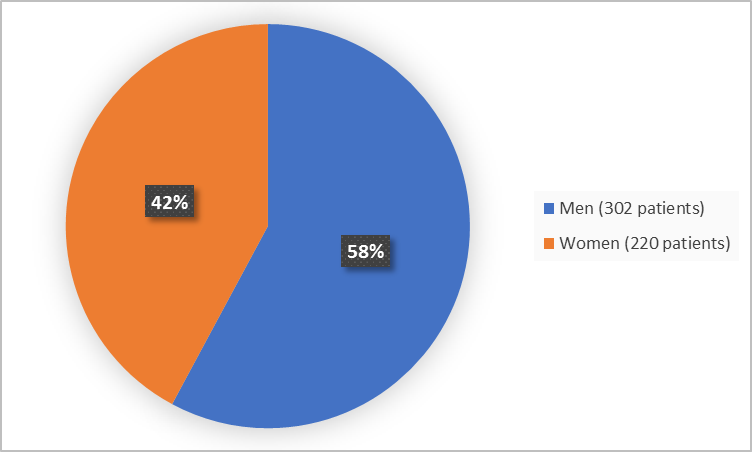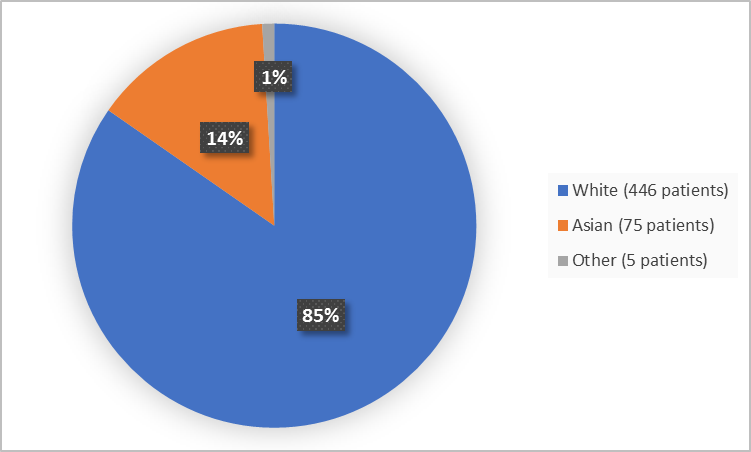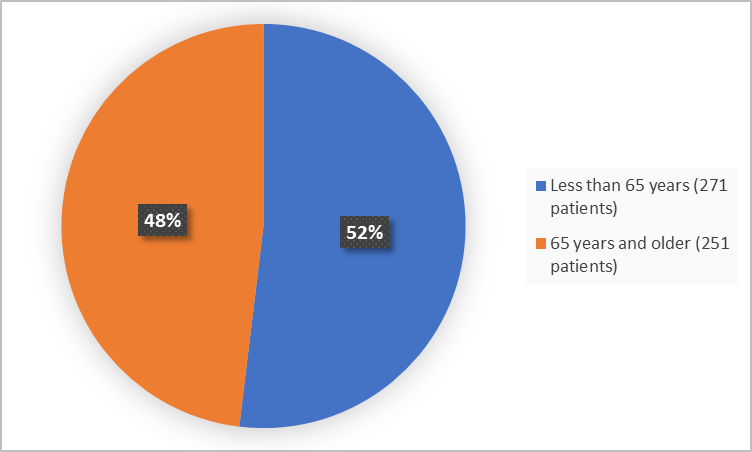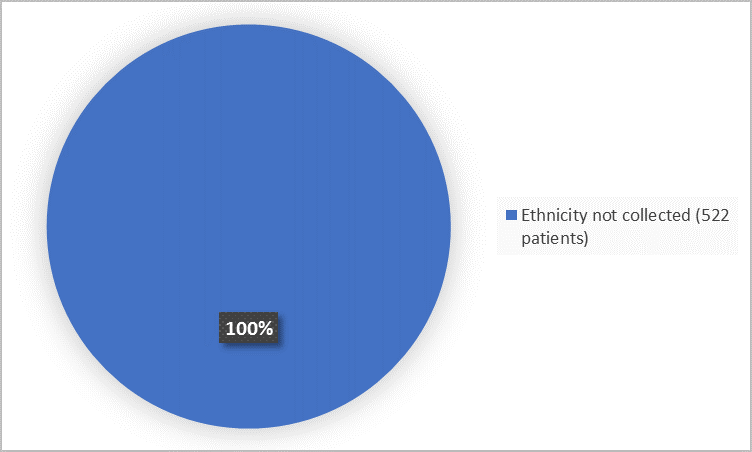Drug Trials Snapshots: ONGENTYS
HOW TO USE THIS SNAPSHOT
The information provided in Snapshots highlights who participated in the clinical trials that supported the FDA approval of this drug, and whether there were differences among sex, race and age groups. The “MORE INFO” bar shows more detailed, technical content for each section. The Snapshot is intended as one tool for consumers to use when discussing the risks and benefits of the drugs.
LIMITATIONS OF THIS SNAPSHOT:
Do not rely on Snapshots to make decisions regarding medical care. Always speak to your health provider about the risks and benefits of a drug. Refer to the ONGENTYS Package Insert for complete information.
ONGENTYS (opicapone)
on-JEN-tis
Neurocrine Biosciences, Inc.
Approval date: April 24, 2020
DRUG TRIALS SNAPSHOT SUMMARY:
What is the drug for?
ONGENTYS is a drug used to treat patients with Parkinson’s disease (PD) who are having “off” episodes while taking drugs (levodopa and carbidopa) for the treatment of Parkinson’s disease.
An “off” episode is a time when a patient’s medications are not working well, leading to an increase in Parkinson’s symptoms, such as tremor and difficulty walking.
How is this drug used?
ONGENTYS is a capsule taken by mouth once daily at bedtime, in addition to drugs for the treatment of Parkinson’s disease (levodopa and carbidopa).
What are the benefits of this drug?
Patients treated with ONGENTYS had decreased “off” time compared to patients treated with placebo.
What are the benefits of this drug (results of trials used to assess efficacy)?
The tables below summarize the efficacy results for individual trials based on the change in mean absolute off-time, assessed by 24-hour patient diaries completed 3 days prior to each of the scheduled visits.
Table 1. Absolute OFF-time (Hours) Change from Baseline to Endpoint-Trial 1
|
|
N |
Baseline |
LS Mean Change from Baseline (SE) |
Placebo-subtracted Difference |
Adjusted |
|
Placebo |
120 |
6.17 |
-0.93 |
-- |
-- |
|
ONGENTYS 50 mg |
115 |
6.20 |
-1.95 |
-1.01 |
p=0.002 |
|
CI=confidence interval; LS =least squares; N=total number of patients; SE=standard error. |
|||||
Table 2. Absolute OFF-time (Hours) Change from Baseline to Endpoint-Trial 2
|
|
N |
Baseline |
LS Mean Change from Baseline (SE) |
Placebo-subtracted Difference |
Adjusted |
|
Placebo |
135 |
6.12 |
-1.07 |
-- |
-- |
|
ONGENTYS 50 mg |
147 |
6.32 |
-1.98 |
-0.91 |
p=0.008 |
|
CI=confidence interval; LS =least squares; N=total number of patients; SE=standard error. |
|||||
ONGENTYS Prescribing Information
Were there any differences in how well the drug worked in clinical trials among sex, race and age?
- Sex: ONGENTYS worked similarly in men and women.
- Race: Most patients were White. Differences in how well the drug worked among races could not be determined.
- Age: ONGENTYS worked similarly in patients younger and older than 65 years of age.
Were there any differences in how well the drug worked in clinical trials among sex, race, and age groups?
The tables below summarize efficacy results by demographic subgroups in the trials. All patients in Trial 1 were White; therefore, race analysis was not conducted.
Table 3. Absolute Off Time (Hours) Change from Baseline by Subgroups-Trial 1
|
Subgroup |
Treatment Arm |
Sample Size |
Baseline Mean (SD) |
LS Mean Diff. from Baseline (SE) |
LS Mean Diff. from Placebo (95% CI) |
|
Sex |
|||||
|
Men |
ONGENTYS 50 mg |
69 |
6.02 (1.64) |
-1.72 (0.29) |
-0.69 ( -1.48, 0.10) |
|
Placebo |
70 |
6.22 (1.63) |
-1.02 (0.29) |
-- |
|
|
Women |
ONGENTYS |
46 |
6.48 (1.97) |
-2.27 (0.36) |
-1.48 ( -2.43, -0.53) |
|
Placebo 50 mg |
50 |
6.10 (1.98) |
-0.79 0.34) |
-- |
|
|
Age |
|||||
|
< 65 years |
ONGENTYS 50 mg |
58 |
6.15 (1.73) |
-1.68 (0.32) |
-0.94 ( -1.80, -0.08) |
|
Placebo |
59 |
6.09 (1.64) |
-0.74 (0.32) |
-- |
|
|
≥ 65 years |
ONGENTYS |
57 |
6.26 (1.85) |
-2.22 (0.32) |
-1.10 ( -1.96, -0.24) |
|
Placebo |
61 |
6.24 (1.91) |
-1.12 (0.31) |
-- |
|
Table 4. Absolute Off Time (Hours) Change from Baseline by Subgroups-Trial 2
|
Subgroup |
Treatment Arm |
Sample Size |
Baseline Mean (SD) |
LS Mean Diff. from Baseline (SE) |
LS Mean Diff. from Placebo (95% CI) |
|
Sex |
|||||
|
Men |
ONGENTYS 50 mg |
89 |
6.36 (2.25) |
-2.03 (0.29) |
-1.27 ( -2.10, -0.44) |
|
Placebo |
71 |
6.16 (2.51) |
-0.76 (0.32) |
-- |
|
|
Women |
ONGENTYS 50 mg |
58 |
6.26 (2.20) |
-1.93 (0.36) |
-0.48 ( -1.43, 0.46) |
|
Placebo |
64 |
6.08 (2.13) |
-1.45 (0.34) |
-- |
|
|
Race |
|||||
|
White |
ONGENTYS 50 mg |
115 |
6.49 (2.31) |
-1.89 (0.28) |
-0.83 ( -1.57, -0.09) |
|
Placebo |
89 |
6.36 (2.43) |
-1.06 (0.32) |
-- |
|
|
All Other |
ONGENTYS 50 mg |
32 |
5.72 (1.79) |
-2.26 (0.52) |
-1.15 (-2.36, 0.05) |
|
Placebo |
45 |
5.66 (2.09) |
-1.10 (0.44) |
-- |
|
|
Age |
|||||
|
< 65 years |
ONGENTYS 50 mg |
65 |
6.40 (2.13) |
-1.80 (0.33) |
-0.73 ( -1.59, 0.13) |
|
Placebo |
84 |
6.16 (2.41) |
-1.06 (0.30) |
-- |
|
|
≥ 65 years |
ONGENTYS 50 mg |
82 |
6.26 (2.31) |
-2.15 (0.31) |
-1.02 ( -1.95, -0.09) |
|
Placebo |
51 |
6.07 (2.20) |
-1.13 (0.38) |
-- |
|
SD=standard deviation; SE=standard error; CI=confidence interval
FDA Statistical Review
What are the possible side effects?
ONGENTYS can cause serious side effects, including heart rate and blood pressure changes when used with certain medicines, falling asleep during normal activities, low blood pressure and fainting, uncontrolled movements (dyskinesia), and unusual urges (impulse control or compulsive behaviors).
The most common side effects of ONGENTYS are uncontrolled movements, constipation, increase in blood creatinine level, fainting, and weight decrease.
What are the possible side effects (results of trials used to assess safety)?
The table below summarizes adverse reactions that occurred in the clinical trials.
Table 5. Adverse Reactions with an Incidence of at Least 2% in Patients Treated with ONGENTYS, and Greater than on Placebo, in Pooled Trials 1 and 2
|
Adverse Reactions |
ONGENTYS 50 mg |
Placebo |
|
Nervous system disorders |
20 |
6 |
|
Gastrointestinal disorders |
6 |
2 |
|
Psychiatric disorders |
3 |
1 |
|
Investigations |
5 |
2 |
|
Vascular disorders |
5 |
1 |
1 Includes hallucinations, hallucinations visual, hallucinations auditory, and hallucinations mixed
2 Includes hypotension, orthostatic hypotension, syncope, and presyncope
ONGENTYS Prescribing Information
Were there any differences in side effects among sex, race and age?
- Sex: The occurrence of side effects between men and women was similar.
- Race: Most patients were White. Difference in the occurrence of side effects among races could not be determined.
- Age: The occurrence of side effects was similar between patients younger and older than 65 years of age.
Were there any differences in side effects of the clinical trials among sex, race, and age groups?
The tables below summarize the occurrences of most common adverse reactions by sex and age. The occurrences by race were not analyzed because of the predominance of White patients.
Table 6. Adverse Reactions by Sex
|
Preferred Term |
ONGENTYS 50 mg |
Placebo |
||
|
Women |
Men |
Women |
Men |
|
|
Dyskinesia |
22 |
19 |
10 |
4 |
|
Constipation |
10 |
4 |
1 |
3 |
|
Urinary tract infection |
9 |
1 |
2 |
0 |
|
Headache |
7 |
2 |
7 |
2 |
|
Dry mouth |
6 |
1 |
0 |
1 |
Table 7. Adverse Reactions by Age
|
Preferred Term |
ONGENTYS 50 mg |
Placebo |
||
|
<65 years |
≥65 years |
<65 years |
≥65 years |
|
|
Dyskinesia |
23 |
18 |
6 |
6 |
|
Constipation |
4 |
9 |
2 |
2 |
|
Headache |
2 |
6 |
5 |
4 |
|
Weight decreased |
2 |
5 |
0 |
0 |
|
Urinary tract infection |
3 |
4 |
0 |
2 |
|
Dizziness |
2 |
4 |
0 |
3 |
FDA Review
WHO WAS IN THE CLINICAL TRIALS?
Who participated in the clinical trials?
The FDA approved ONGENTYS based on evidence from 2 clinical trials (Trial 1/ NCT01568073, and Trial 2/NCT01227655) of 522 patients with PD whose symptoms were not well controlled while receiving their regular PD treatment. Trial 1 was conducted at 104 sites in 19 European countries, and Trial 2 was conducted at 69 sites in Argentina, Australia, Belgium, Chile, Czech Republic, Estonia, India, Israel, South Korea, Russia, South Africa and UK.
Figure 1 summarizes how many men and women were in the clinical trials
.
Figure 1. Baseline Demographics by Sex
Adapted from FDA Review
Figure 2 summarizes the percentage of patients by race in the clinical trials.
Figure 2. Baseline Demographics by Race
Adapted from FDA Review
Figure 3 summarizes the percentage of patients by age group in the trials.
Figure 3. Baseline Demographics by Age
Adapted from FDA Review
Figure 4 summarizes the percentage of patients by ethnicity in the trials.
Figure 4. Baseline Demographics by Ethnicity
Adapted from FDA Review
Who participated in the trials?
The table below summarizes the demographics for the clinical trials.
Table 8. Demographics for the Trial Population (safety population)
|
Demographic Parameters |
Trial 1 |
Trial 2 |
Total |
|
Sex, n (%) |
|
|
|
|
Men |
140 (59) |
162 (57) |
302 (58) |
|
Women |
96 (41) |
124 (43) |
220 (42) |
|
Race, n (%) |
|
|
|
|
White |
236 (100) |
206 (72) |
442 (85) |
|
Black or African American |
0 |
0 |
0 |
|
Asian |
0 |
75 (26) |
75 (14) |
|
Other |
0 |
5 (2) |
5 (1) |
|
Age (years) |
|
|
|
|
Median |
64.5 |
64 |
64 |
|
Min, Max |
36,83 |
36,83 |
36, 83 |
|
Age Group, n (%) |
|
|
|
|
< 65 years |
118 (50) |
153 (53) |
271 (52) |
|
≥ 65 years |
118 (50) |
133 (47) |
251 (48) |
|
Ethnicity, n (%) |
|
|
|
|
Not Collected |
236 (100) |
286 (100) |
522 (100) |
|
Region, n (%) |
|
|
|
|
United States |
0 |
0 |
0 |
|
West Europe |
47 (20) |
34 (12) |
81 (16) |
|
Rest of the World |
189 (80) |
252 (88) |
441 (84) |
Adapted from FDA Review
How were the trials designed?
There were two 12-week trials conducted in PD patients with inadequate control of their Parkinson’s symptom (“off” time) while receiving carbidopa/levodopa PD medications. Patients were randomly selected to receive either ONGENTYS or a placebo capsule once a day. Neither the patients nor the health care providers knew which treatment was being given until the trial was completed.
In all trials, patients kept daily diaries of the number of hours of “off” time for the 3 days before the evaluation visit. The benefit was evaluated by measuring the change from baseline in total daily “off” time in ONGENTYS- and placebo-receiving patients.
How were the trials designed?
The safety and efficacy of ONGENTYS as the adjunctive treatment to levodopa/carbidopa in patients with Parkinson’s disease experiencing “off” episodes was evaluated in two randomized, multicenter, double-blind, 12-week placebo-controlled trials.
Patients enrolled in the trials had been treated with levodopa/DOPA decarboxylase inhibitor (DDCI) (alone or in combination with other PD medications) and continued their treatment during the trials following randomization to ONGENTYS or placebo. The trials measured the change mean absolute off-time based on 24-hour patient diaries completed 3 days prior to each of the scheduled visits.
GLOSSARY
CLINICAL TRIAL: Voluntary research studies conducted in people and designed to answer specific questions about the safety or effectiveness of drugs, vaccines, other therapies, or new ways of using existing treatments.
COMPARATOR: A previously available treatment or placebo used in clinical trials that is compared to the actual drug being tested.
EFFICACY: How well the drug achieves the desired response when it is taken as described in a controlled clinical setting, such as during a clinical trial.
PLACEBO: An inactive substance or “sugar pill” that looks the same as, and is given the same way as, an active drug or treatment being tested. The effects of the active drug or treatment are compared to the effects of the placebo.
SUBGROUP: A subset of the population studied in a clinical trial. Demographic subsets include sex, race, and age groups.




